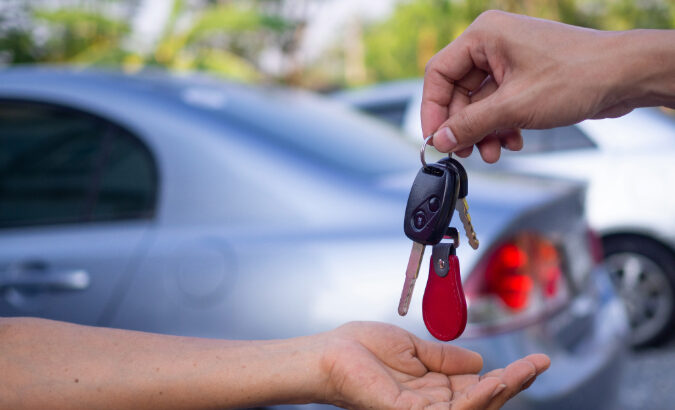
Buying a used car can be daunting. No one wants to mistakenly purchase a “lemon” riddled with defects that aren’t apparent at first sight. Thankfully, there are many resources and tools that can help you make an educated buying decision. Here are some tips to help make the used-car-buying process more manageable.
1. Do some general used car research
Before you go to the dealer and start looking at cars, make a list of the car models you’re targeting. Once you have your list, research each car model to find out common defects, repair costs and price points when they begin to age. With your research in hand, you’ll enter the market with some bargaining power and a keen eye for the weak points in each car model.
2. Set a budget and stick to it
Downpayment recommendations vary when purchasing a new or used car. But the higher your downpayment, the lower your monthly payments. Each person’s financial situation is unique. So knowing your monthly income and expenses can help you figure out how much you can comfortably spend on a car. Once you have that number, decide how much of a downpayment you’d like to make based on your situation.
CNBC reported that the average downpayment for used cars in the first quarter of 2024 was about 16%. [1] Keep in mind, you’ll need to factor in repairs and maintenance. In addition to repair costs, it is also a good idea to research car insurance quotes and calculate vehicle fuel or charging costs.
Determine if you want a used vs. CPO car
You will also need to decide if you want to purchase your car as used or certified pre-owned (CPO). According to Autotrader, a CPO car is a previously owned vehicle that’s usually less than 5 years old and usually has fewer than 60,000 miles on it. [2] Some reasons to buy a CPO car are that they are preselected, inspected and come with extended warranties and several additional services, which can offer you peace of mind. One of the main drawbacks of purchasing a CPO vehicle is that it will cost more than a used vehicle due to the inspections.
Mileage and added features can affect a car’s value, so cars of the same model, trim level and year may have different price tags. Kelley Blue Book’s pricing tool can help you get a price quote. [3]
3. Find the best used car deals
Aside from dealerships, you can find great deals on used cars at local public auctions and on used car websites. Each source has its merits.
- Dealerships: Depending on the dealership, you may find a wide selection of used cars available. They also often offer extras such as new tires, a second key and floor mats. And if it’s a local dealer, you also get the benefit of seeing the cars in-person.
- Online: Websites such as autotrader.com have listings from private sellers all over the country. Search locally and you might even find a gem in your own area.
- Auctions: Steep discounts can be found at car auctions, but vehicles are typically sold without warranties. Be sure to do your homework and learn as much about the car’s history and status as you can.
4. Review the window sticker on the car
The window sticker on a used car is required to provide certain information, including whether the vehicle is being sold “as-is” or with a warranty, and what percentage of potential future repair costs the dealer will pay. If the vehicle is marked “as-is,” this means the dealer makes no guarantees for the condition of the vehicle and any problems that come after you purchase the used vehicle are the buyer’s responsibility. Certain states don’t allow vehicles to be sold “as-is” above a certain price point. [4]
5. Have questions ready for the seller
When contacting a dealer or a private seller, get as much information about the used car as possible. Don’t be shy; dealers expect their buyers to come prepared with questions.
Questions to ask when buying a used car:
- Why is the car being sold?
- How many previous owners have there been?
- Can you describe the condition of the car?
- What is the mileage on the odometer?
- Was the car involved in any collisions?
- Has the car had any electrical damage?
- Has the car been in a flood or other harsh weather event?
- Has this model had any recalls?
- When did this vehicle last go through inspection?
6. Conduct your own car inspection
Before taking it for a spin, make sure to carefully inspect it and check for anything that could potentially lead to headaches in the future.
This means checking the exterior for signs of body repair, damage, rust and the shape of the tires, as well as the interior for any strange odors, wears in the upholstery, and the functionality of the controls. You will also want to remember to look underneath the hood to make sure everything works properly. If possible, take the car to a trusted mechanic for a more detailed analysis.
7. Take a test drive in the used car
After giving the car a thorough examination, it’s time to get behind the wheel for a test drive. Test the car both in a large parking lot and on a road where you can drive the vehicle above 60 mph. To properly assess the used car, take your time when doing a test drive, safely testing out all the components, including:
- Steering-wheel alignment
- Brakes
- Windshield wipers
- Air conditioning/heating
- Power windows
- Headlights, directional lights, taillights
- Audio and infotainment system (if applicable)
8. Get a vehicle history report
Some sellers may not disclose major problems to the buyer. To avoid purchasing a lemon, write down the vehicle identification number (VIN) — a 17-digit code found at the dashboard — and look up the number on sites such as CARFAX or Autocheck to get a detailed vehicle history report.
9. Negotiate the price
Look up the current market value in a pricing guide such as Kelly Blue Book to arm yourself with solid information to base your negotiation. Remember to stick to your budget and price limitations. If the salesperson makes a counteroffer close to the current market value, you’re getting close to a good deal. If the final asking price is unreasonable, you can always walk away from the deal. [5]
Buying a used vehicle from a private seller could be an option if you plan to pay cash. Negotiating used car prices with a private seller could lead to a better deal, but keep in mind that you might not get any type of warranty with the purchase. [5]
10. Use your instincts
A little common sense can go a long way when purchasing a used car. Ask yourself if the dealer seems trustworthy. Know about techniques that are used to hide flaws, such as using air fresheners to mask strange odors and tampering with odometers.
Avoid making an impulse buy just because you finally found a car that looks nice, and don’t give in to high-pressure sales tactics. If it seems too good to be true, it may be worth stepping away for a day or two to consider your options.
Should you buy an extended warranty on a used car?
If you’re on the fence about buying an extended warranty, consider the following questions:
- Are you concerned about your vehicle being unreliable?
- Will a warranty relieve your anxiety?
- Are you willing to pay for a service you may not use?
- Do you plan on using the vehicle for a long time?
- Are you willing to stick to the warranty’s maintenance schedule?
If you answered yes to many of those questions, you might want to look into an extended warranty. [6]
When is the best time to buy a used car?
Because dealerships have quotas to meet, it may be beneficial to shop for cars at the end of the month, quarter or year in hopes that the salesperson could be more willing to negotiate to meet their goal.
Also, shop when the weather is fair so that the sun can show dents, dings, scratches, rust, bubbling paint and any other flaws the exterior may have. Buying in the winter or the off-season means the demand could be lower, but so are the prices, according to Chase. [7]
Do you need insurance to buy a used car?
Before buying a car, you can talk to your insurance agent to ask questions and learn about any coverage implications. Waiting to buy a vehicle until you’ve sorted out your insurance needs could inform your choice of car because some vehicles may carry higher insurance rates. [8]
Don’t have an agent? Find an independent Nationwide agent today.
Sources:
[1] “How much you need for a down payment on a car,” Senitra Horbrook, cnbc.com/select/how-much-car-down-payment/ (Accessed February 2025).
[2] “What is a Certified Pre-Owned Car?” Joe Tralongo, autotrader.com/car-shopping/what-certified-car (Accessed December 2024).
[3] “Certified Pre-Owned Pros and Cons,” kbb.com/car-advice/certified-pre-owned-pros-and-cons (Accessed December 2024).
[4] “Expert Tips on how to Inspect a Used Car,” Jon Linkov, consumerreports.org/cars/how-to-inspect-a-used-car-a1377126659/ (Accessed February 2025).
[5] “How to Negotiate to Buy a Used Car,” Joe D’Allegro nerdwallet.com/article/loans/auto-loans/negotiating-basics-buying-car (Accessed December 2024).
[6] “Is an Extended Car Warranty Worth It?” Elizabeth Rivelli, caranddriver.com/auto-loans/a41685681/is-extended-car-warranty-worth-it (Accessed December 2024).
[7] “When is the best time to buy a used car?,” chase.com/personal/auto/education/buying/best-time-to-buy-a-used-car (Accessed December 2024).
[8] “8 insurance points to consider before buying a car,” nationwide.com/lc/resources/auto-insurance/articles/insurance-tips-for-car-buyers (Accessed December 2024).
Disclaimer:
The information included is designed for informational purposes only. It is not legal, tax, financial or any other sort of advice, nor is it a substitute for such advice. The information may not apply to your specific situation. We have tried to make sure the information is accurate, but it could be outdated or even inaccurate in parts. It is the reader’s responsibility to comply with any applicable local, state or federal regulations. Nationwide Mutual Insurance Company, its affiliates and their employees make no warranties about the information nor guarantee of results, and they assume no liability in connection with the information provided. Nationwide, the Nationwide N and Eagle and Nationwide is on your side are service marks of Nationwide Mutual Insurance Company. © 2025 Nationwide



